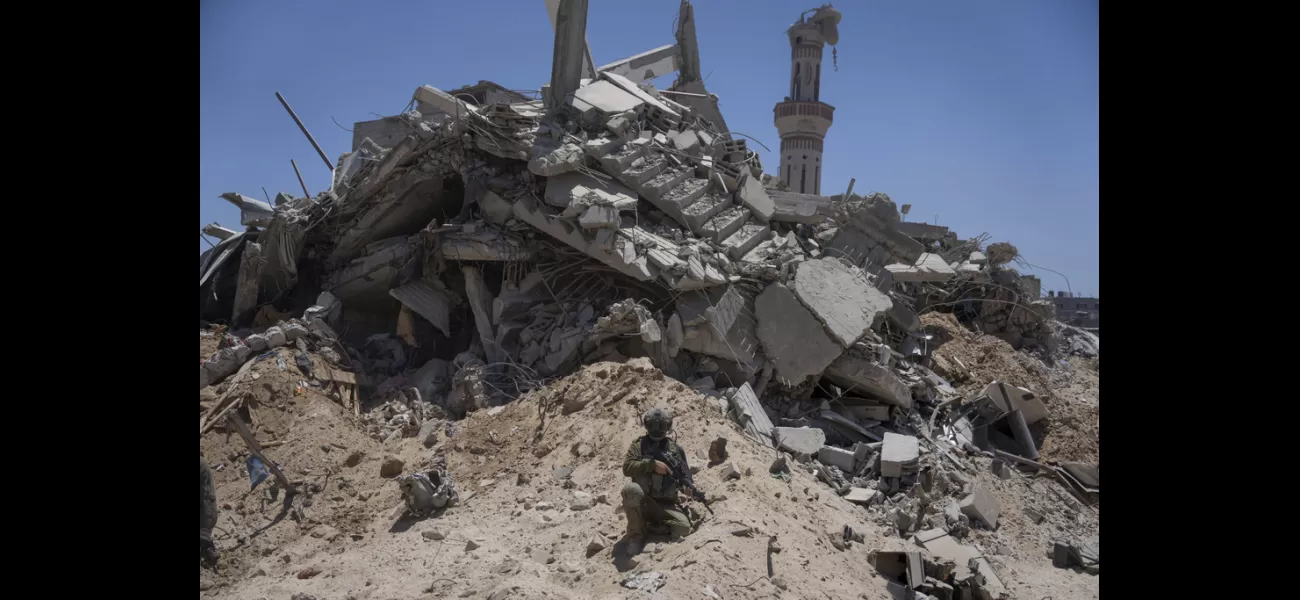2 million people's home now deserted, covered in dust and debris.
Destroyed apartments with bullet holes and broken windows, exposing rooms like bedrooms and kitchens, can be seen from rubble-filled roads.
July 7th 2024.

Two months ago, the city of Rafah was a bustling hub for over 2 million people in Gaza. Today, it is a desolate and dusty ghost town. The streets are lined with abandoned buildings, their walls blasted open and windows shattered. The remnants of people's lives, such as bedrooms and kitchens, are now visible from the roads that are littered with rubble and debris. The only vehicles passing by are those of the Israeli military, as very few civilians remain in the city.
According to Israel, their ongoing offensive against Hamas in Rafah has almost completely defeated the militant group. This area was identified as their last stronghold in Gaza earlier this year. The Israeli military recently allowed international media to visit Rafah for the first time since their invasion on May 6. However, they have barred independent journalists from entering Gaza since the beginning of the war in October, which was sparked by a Hamas attack.
Before invading Rafah, Israel claimed that four of Hamas' remaining battalions had retreated there. This area, which borders Egypt, covers about 65 square kilometers. Israel has stated that hundreds of militants have been killed in their offensive, but there have also been numerous civilian casualties, including women and children, from Israeli airstrikes and ground operations. The military justifies their intense operations by claiming that Hamas has turned civilian areas into dangerous traps. This was evidenced by the death of eight soldiers from a single blast last month.
During the tour of Rafah on Wednesday, the military's chief spokesman, Rear Admiral Daniel Hagari, pointed out a booby-trapped tunnel and stated that Hamas has built their infrastructure in civilian neighborhoods, including houses and mosques. This tactic has created a "terror ecosystem" in the city. Before the war, Rafah had a population of around 275,000, but an estimated 1.4 million Palestinians fled there to escape the fighting elsewhere in Gaza. The UN estimates that around 50,000 people still remain in Rafah, most of whom have moved to a nearby "humanitarian area" declared by Israel. Conditions in this area are dire, with limited access to basic necessities such as clean water, food, and medical care.
Efforts to bring aid into southern Gaza have been hindered by the Israeli incursion into Rafah, which has closed down one of the main crossings into the south. The other main crossing, Kerem Shalom, is also too dangerous for aid convoys to use, as they are vulnerable to attacks by armed groups searching for contraband. This has resulted in a delay in aid delivery, and the UN reports that only a few commercial trucks have been able to enter Rafah, with hired armed guards riding atop the convoys.
Despite these challenges, Israel remains confident in their efforts to dismantle Hamas as an organized military force in Rafah. As a reflection of this confidence, soldiers brought journalists into the city in open-air military vehicles, highlighting the destruction along the way. This included the remnants of aid delivery attempts, such as burnt truck carcasses and empty pallets. However, the longer aid delivery is delayed, the more dire the situation becomes for the people of Gaza. Critical services, such as hospitals, are facing shortages of fuel, which is also needed for water desalination plants and transportation.
Dr. Hanan Balkhy, the regional director for the World Health Organization, reports that hospitals are once again facing shortages and delays due to the lack of fuel. This has resulted in injured people dying while waiting for ambulance services. As the humanitarian situation worsens, Israel continues their offensive in Rafah. The sound of gunshots could be heard nearby during the journalists' visit, causing the soldiers to change their plans and avoid visiting the beach as originally intended. The group ultimately left the city, leaving behind a trail of dust kicked up by their vehicles, temporarily obscuring the devastation behind them.
According to Israel, their ongoing offensive against Hamas in Rafah has almost completely defeated the militant group. This area was identified as their last stronghold in Gaza earlier this year. The Israeli military recently allowed international media to visit Rafah for the first time since their invasion on May 6. However, they have barred independent journalists from entering Gaza since the beginning of the war in October, which was sparked by a Hamas attack.
Before invading Rafah, Israel claimed that four of Hamas' remaining battalions had retreated there. This area, which borders Egypt, covers about 65 square kilometers. Israel has stated that hundreds of militants have been killed in their offensive, but there have also been numerous civilian casualties, including women and children, from Israeli airstrikes and ground operations. The military justifies their intense operations by claiming that Hamas has turned civilian areas into dangerous traps. This was evidenced by the death of eight soldiers from a single blast last month.
During the tour of Rafah on Wednesday, the military's chief spokesman, Rear Admiral Daniel Hagari, pointed out a booby-trapped tunnel and stated that Hamas has built their infrastructure in civilian neighborhoods, including houses and mosques. This tactic has created a "terror ecosystem" in the city. Before the war, Rafah had a population of around 275,000, but an estimated 1.4 million Palestinians fled there to escape the fighting elsewhere in Gaza. The UN estimates that around 50,000 people still remain in Rafah, most of whom have moved to a nearby "humanitarian area" declared by Israel. Conditions in this area are dire, with limited access to basic necessities such as clean water, food, and medical care.
Efforts to bring aid into southern Gaza have been hindered by the Israeli incursion into Rafah, which has closed down one of the main crossings into the south. The other main crossing, Kerem Shalom, is also too dangerous for aid convoys to use, as they are vulnerable to attacks by armed groups searching for contraband. This has resulted in a delay in aid delivery, and the UN reports that only a few commercial trucks have been able to enter Rafah, with hired armed guards riding atop the convoys.
Despite these challenges, Israel remains confident in their efforts to dismantle Hamas as an organized military force in Rafah. As a reflection of this confidence, soldiers brought journalists into the city in open-air military vehicles, highlighting the destruction along the way. This included the remnants of aid delivery attempts, such as burnt truck carcasses and empty pallets. However, the longer aid delivery is delayed, the more dire the situation becomes for the people of Gaza. Critical services, such as hospitals, are facing shortages of fuel, which is also needed for water desalination plants and transportation.
Dr. Hanan Balkhy, the regional director for the World Health Organization, reports that hospitals are once again facing shortages and delays due to the lack of fuel. This has resulted in injured people dying while waiting for ambulance services. As the humanitarian situation worsens, Israel continues their offensive in Rafah. The sound of gunshots could be heard nearby during the journalists' visit, causing the soldiers to change their plans and avoid visiting the beach as originally intended. The group ultimately left the city, leaving behind a trail of dust kicked up by their vehicles, temporarily obscuring the devastation behind them.
[This article has been trending online recently and has been generated with AI. Your feed is customized.]
[Generative AI is experimental.]
0
0
Submit Comment





